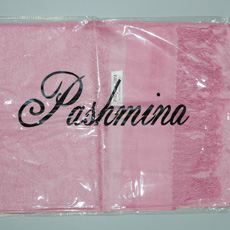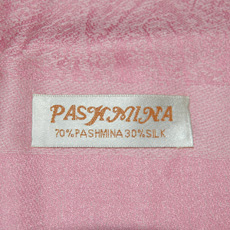Original or fake?
In this article you will learn:
+ How to detect particularly bad counterfeit items
+ What makes a good cashmere shawl
Have you ever wondered about the myriad of affordable, luxurious cashmere shawls you are constantly offered on the street or on the Internet? Read this article and stop wondering.
In test purchases on the Internet, but also in contact with traders from India or Nepal, we repeatedly encounter cloths boasting a "100% cashmere" or "70% cashmere, 30% silk" quality, which are remarkably inexpensive, some of them even below 20 Euro. Now, if you consider that even unprocessed, low-quality cashmere (!) costs approximately $ 100 / kilo, and that a pashmina shawl weighs at least 180 grams, it seems obvious that something is off. Other manufacturers or sellers, in an attempt to convey a high-quality product image, use statements such as "Gold" and "Silver", or introduce bogus A, B and C classifications. These designations are pure inventions, and suggest rather a forgery than fine cashmere products. Using a microscope, you can easily discern how those surprisingly inexpensive cloths were indeed manufactured. Quite often, you will be looking at rayon or other chemical fibres, whose trade purchase price is below one Euro, or treated goods made from sheep wool. As people wear these products, they immediately feel the difference in quality on their own skin: only cashmere products feel like cashmere products.
How can you protect yourself as a consumer from fraud?
The label
We conduct regular quality checks on our own products and know precisely what to look for: First, check the label and pay special attention to the manufacturer's material specifications. The German Textile Labelling Act requires material specification such as "70% cashmere, 30% silk", or "100% cashmere" or "Pure cashmere". Conversely, statements such as "100%  Pashmina" are highly suspicious, as Pashmina is neither a wool type nor a permissible textile labelling under German law. This misrepresentation allows resourceful traders to circumvent difficulties in customs inspection and avoid criminal and civil consequences. In most cases, you can safely assume that a shawl with the word "pashmina" does not contain an ounce of cashmere.
Pashmina" are highly suspicious, as Pashmina is neither a wool type nor a permissible textile labelling under German law. This misrepresentation allows resourceful traders to circumvent difficulties in customs inspection and avoid criminal and civil consequences. In most cases, you can safely assume that a shawl with the word "pashmina" does not contain an ounce of cashmere.
The fabric
Quality can also be read on the fabric itself. First, if the substance feels cold and slightly shiny, then it is certainly viscose. These inferior synthetic fibres are often used in Turkish, Indian and Chinese imitations, because they can be easily produced at negligible costs. However, if the fabric feels warm to the touch, this may indicate the presence of cashmere. Unfortunately, other materials, such as polyethylene or polyester, convey a similar feeling. Therefore, how can we distinguish between "warm" fabrics of cashmere and synthetic fibre? The simplest method is the so-called burn test: Pluck a few hairs from the cloth and burn them. If they burn quickly and the smoke smells of burnt paper, then you're probably holding rayon in your hand. On the other hand, if it burns with a bright, large flame, you are possibly dealing with chemical fibres, such as polyethylene or polyester. Depending on the specific fibre composition, the material sample can melt into a small lump. Wool or cashmere wool can be recognized because the fabric is difficult to burn; it lets off a sweet smell of burnt hair or fingernail, and produces a fibrous residue with bead-like nodules, which can be ground. So, the only question left open is: how can we distinguish cashmere wool from other wool types, such as the inferior quality, treated sheep wool.
The fringes
As an impartial observer would do, we concentrate on the appearance of fringes. Our fringes are always cleanly drilled and carefully knotted. Furthermore, as you slightly push apart the nodes, you will never see white spots on fringes, unfortunately a common occurrence these days. Indeed, those white spots indicate that the pashmina was only coloured as a finished, manufactured product. Above all, Indian Pashmina counterfeiters resort to this trick for obvious financial reasons.
Our quality assurance
Merck's goods encyclopedia from 1884 hits the nail on the head:
"Only now do real Indian shawls become a highly appreciated item, standing above all other fashion articles. The trade, however, requires a connoisseurship as precise as that of a gem dealer in his profession".
After 120 years, this quote proves still valid Unfortunately, the forgeries - e.g., those introduced by new methods for treatment of inferior wool - are now so sophisticated that knowledge alone is no longer sufficient.
We regularly review our cashmere products under a Bresser microscope with a magnification of one thousand. Since such a cursory examination is insufficient, we submit or products to the quality examination of an internationally recognized laboratory in Germany. If qualities are not satisfactory or the cashmere presents impurities, we return the goods to the suppliers without compromise.
For further information
- Textile testing methods (especially the burn test) are available in the literature, such as: Alfons Hofer: Fabrics. Volume 1: Raw materials: fibres, yarns, and effects, Frankfurt 2000
- The history of Cashmere shawls: Merck's goods encyclopedia, keyword "Shawl", Volume 21, 3rd Edition, Leipzig 1884

